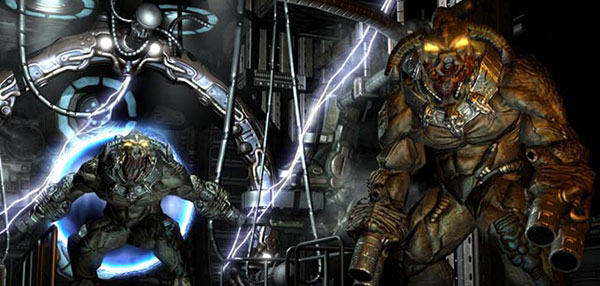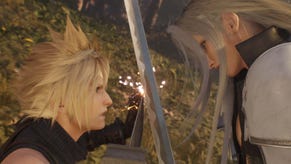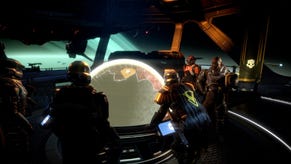Interview: Prey 2's Oddness, Freedom & Ians
So we already know the broader picture of Prey 2 - a sandbox 'alien noir' world, with you as a bounty hunter taking on contracts - and how it's a far cry from the first game, but what about the details? Let's ask Prey 2 developer Human Head's project lead Chris Rinehart and chief creative officer Jim Sumwalt for a closer look at just how the missions, the morality and the money-making works - as well as why they decided to leave the first game's play style behind, why the themes are similar even if the lead character is not, whether it's all urban or if things get wilder, and why the hell he's called 'Killian Samuels...'
RPS: How have fans responded to the direction you've taken so far, and the loss of stuff like portals?
Chris Rinehart - I think that people need to see more of what we have to offer. Once you actually get to see the demo and the wealth of gameplay that's there... Because the one thing that isn't quite there is the fact that isn't just like a real easy type of sequel. This is a very ambitious game, a very large game - there's a lot of stuff that you can do in it. I think that's something that the players are really going to latch onto and really like once they can see the scope of everything that we're doing. Even today, we only showed a small subset of the gadgets and the world that we have in Prey 2.
RPS: How did you end up moving onto something so different?
Chris Rinehart: When we first met with Bethesda and signed with them, we wanted to explore both sides of predator/prey, let the player be a predator more, and what popped out of that was that bounty hunting made a lot of sense. 'I would like to be a bounty hunter on this alien world'. And we knew that we would need to find a new space to take the player to, because we blew up the sphere and we wanted to take the player to a new space and explore that. The other thing that led us to where we are today is the fact that Prey 1 was very much an origin story - finding your roots, who you are. There's definitely a part of that in Prey 2 is that Killian, when he wakes up on this planet, has no recollection of how he got there, other than getting smacked in the face. So he's kind of uncovering that mystery of what happened to him [in the intervening time], what he was up to… actually, what he and Tommy were up to during the time-frame he doesn't recall.
The other thing, and this is a little bit abstract, is that Prey 1 was also about being a stranger in a stranger land. Not only Tommy being this human in this alien planet, but also the Native American themes - Tommy felt like he didn't have a place where he fit in this world. There's definitely those themes in Prey 2 as well, because Killian initially thinks he's the only human on this planet. He definitely stands out as well, because it's a melting pot, this world, but still he's the only human, so when the aliens see him they react in certain ways, treat him as though he's the only human. And of course, later on as you play more, they start treating you a little differently again because you become more known as a bounty hunter as well - so they recognise you not only as that human, but that bounty hunter.
RPS: So though there are people who are upset that you've lost the Native American character, you think you're going to evoke similar stuff sufficiently by Prey 2 retaining the themes of displacement?
Chris Rinehart: We absolutely do, yeah. Definitely.
RPS: Is there any Bethesda-wide resource sharing going on? There's quite a bit of open world and also Parkour stuff (with Brink) in here…
Jim Sumwalt: Purely coincidental. We wanted to go with open world motif and taking the first-person experience to a new place we'd always kind of wanted to do that - the freedom of exploration was just a natural extension of wanting to push the experience.Then we got a relationship with Bethesda and it was like 'oh, hey, Brink!'
Chris Rinehart - There was a little bit of comparing notes, like "so how did you guys do it? Oh, I see how that wants!" They are different in how they are implemented.
RPS: And id, as you're using their engine?
Chris Rinehart: Honestly, we don't talk to them that much, because although it's their tech we built a lot of stuff on top. Actually there's a funny story that when we developed Prey 1 we were using id Tech, and this was before Prey was even been announced and we'd been working with it for quite a while. So the id guys called us and said "are you guys still using our tech? You're still around? What's going on over there?" We're really kind of self-sufficient, building our own stuff as we need, but that's not to say that in another year we won't pick up the Bethesda bone.
RPS: To what extent can you live out the bounty hunter fantasy without the main story taking over? Could I spend, say, 10 hours just doing my own thing, exploring and taking random contracts before I have to engage with the core narrative?
Chris Rinehart: Totally, absolutely.
RPS: What breadth of content is there? Will we see a lot of stuff sort of repeating, like 'here's yet another roadside beating I can intervene in'?
Chris Rinehart: There's definitely categories to that, like people in peril - whether it's the guy being beaten, or another guy getting threatened to be shoved off the edge in front of the trains or something like that. There can be difference scenarios with those though - sometimes it could be one aggressor, other times multiple aggressors which will obviously change how you approach the situation, or if you even want to.
There will also be collectibles, but all of those we want to tie in and make sense from a narrative perspective - so not just collecting little bobbles that kind of make sense. One example is one of the factions in the game set up these kinds of tracers around that are tracking movements of police, and of all the citizens. If you go around and start destroying those, one of the other factions will start paying you money. So it turns into a thing of going and destroying all of these things as a job.
Jim Sumwalt: And all the areas are having their own conflicts and their own stuff that's happening as a backdrop which is going to change those conditions. So while you're freely going around doing your thing, there could be a conflict happening where there wasn't before, and now that's going to change that dynamic when you're playing it.
RPS: Is there an element of picking a faction you want to side with?
Chris Rinehart: It doesn't change the story, but if you want to try to align with a faction, do more of their missions, more of their open world stuff, you totally can do that. But a big part of the game, actually the interesting thing with the game, is pitting the factions against the other. For example, there's a mission where one of the factions hires you to go and steal a bunch of weapons from the other faction, so you go over there and you steal a bunch of those weapons. The faction that you've just robbed contacts you later and says "hey, someone just robbed a bunch of our stuff - we need to find and track down the person who did this."
RPS: Are you exploring any racial prejudice elements to these factions, given the multi-species nature of the planet?
Chris Rinehart: There's some of that. One of the species is kind of a down-trodden people that everyone else just beats on, and they're the thumping boys of the universe. There's an aspect of that.
RPS: How much does moral decision-making factor into what missions you take and how you resolve them?
Jim Sumwalt: It's more short-term, there's not a sense of 'am I right or wrong, good vs evil, Darth vs Luke' - it's noir. Nobody's innocent, everybody's degrees of bad, everyone's got agendas, so the choices that you make and the reputations you have are for certain games within a certain time-frame of the game experience. It's not going to deliver a Darth experience.
RPS: Must be pretty refreshing to play around in those grey areas after having previously done Hero vs Monsters?
Jim Sumwalt: Right, and you know it was a lot of "it's coming at me, it's gonna bite me, shoot it!' It's more complex now - the interactions between the guy you shoot or don't shoot, truly refreshing.
Chris Rinehart: And we don't do anything like judging the player for taking one action or the other, but we do kind of point it out. There's one mission where you get contacted by a client who wants you to take this target out. So you head over and on the way the target contacts you and say "I know you're after me, hunter. Tell you what, I'll pay you double if you go and kill the original client." So it's your choice - do you keep going and kill the guy, or do you get back? If you do go back and kill the original guy, someone else will come and say "wow, that was cold." Again, it's not really judging, it's just commenting on, kind of reinforcing what you're doing.
RPS: How much context can you get in that kind of dispute? Can you sleuth out who's right and who's wrong and make a real judgement, other than just what you think the reward is?
Chris Rinehart: You definitely can, yeah. We've got a number of those. There's another mission where you're going after a target, and because you've got this comms system almost anyone can contact you. So the target contacts and says "I'm actually innocent, you can't do this." So you're trying to track the guy down and having a hard time - he's a pretty slippery guy. Then he contacts you and says, "I'll make you a deal. I'm innocent, totally innocent, you gotta let me go but I know you're not going to let me go and the client's not going to give up until there's a body. So I've found a guy who looks like me. I want you to kill him instead of me - will you do that?" And then it's your choice, of killing the original guy or just this other one who happens to be just this street vendor who's minding his own business? If you do that, from a moral standpoint…
RPS: …You're really just a murderer.
Chris Rinehart: Yeah, exactly. Not so good. But again it's just your choice how you wanna play it.
RPS: You mentioned Red Dead Redemption as an influence - what other open world stuff has inspired you?
Chris Rinehart: I always try to shy away from using too many other games as examples, just because someone might pick something out of that game that we're not actually doing. But we've played a ton of different open world games - Borderlands, the Assassin's Creeds, all of those. More for a comparison for everything that we're doing, just to make sure we're not missing some aspect that players might be expecting. But Borderlands is one of my favourite games of recent years, and in terms of the benchmark for open world: Red Dead.
RPS: Have you had much experience with STALKER? In my ideal world, every developer is inspired by that to some degree…
Chris Rinehart: Yeah, it's a really good game.
RPS: Do you think this philosophy of the Prey games being such a departure from each other would extend to any future titles in the series?
Chris Rinehart: Possibly. We've got plans narratively as to what we'd like to pull off for Prey 3, but in terms of actual gameplay - maybe. Kind of being a little coy on purpose…
RPS: How weird are you going to get aesthetically? While the Blade Runner thing is cool, it's kind of a familiar sci-fi setting in a way - will things get wilder later?
Jim Sumwalt: Yes, there will be an element of weird alien flora and fauna stuff on Exodus. And then there's the sense of the grotesque that people always associate with Prey 1 - we definitely want to keep that going to some degree, but like I said before, with the AI and the NPCs in the first game it was basically just things that wanted to eat you or kill you. Now the population of humanoid, higher-level thinking organisms caused us to have conditions to levels and backdrops that are more like cities. You're not fighting off bears and wolves in the woods on the way to finding one lone guy in the log cabin who's got a bounty on his head. It's playing people against each other and getting information.
We didn't want to spend a lot of time explaining to the player how you use this or that - that this weird alien thing is actually a door or this is a nightclub. Working with our art director, we decided that we should start with the recognisable and move to the weird, versus starting from the weird and trying to discern some sort of form or utility.
RPS: I got a little bit of a Predator vibe from the main character - the climbing stuff, the shoulder-mounted rocket launcher, the vision modes. Is that conscious?
Jim Sumwalt: Oh definitely, definitely. 'Prey 2: Predator.' [Laughs]
RPS: Where on earth did the name 'Killian Samuels' come from?
Chris Rinehart: I've always loved the name 'Killian', I just thought it was a really cool name.
Jim Sumwalt: And of course there's the 'Kill Ian'…
RPS: Who is this Ian guy, and what's he done to you?
Chris Rinehart: [Laughs] That's our final boss. Evil Ian Samuels. It's like Kill Bill.















